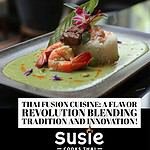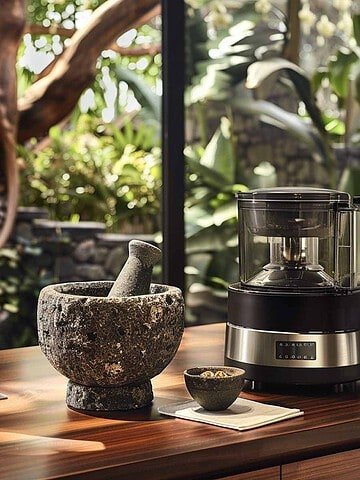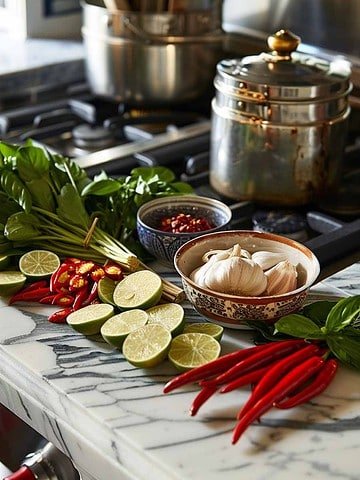
Thailand, renowned for its vibrant and diverse culinary landscape, has increasingly become a global leader in the realm of fusion cuisine. This culinary movement not only celebrates Thailand's rich culinary traditions but also integrates international influences in innovative and unexpected ways. From street food stalls to high-end restaurants, Thai chefs are not just blending traditional flavors with global techniques, but they are doing so with a level of creativity that is truly inspiring.
Their dishes appeal to both local palates and international food enthusiasts alike, showcasing the limitless possibilities of fusion cuisine.
Thailand, renowned for its vibrant and diverse culinary landscape, has increasingly become a global leader in the realm of fusion cuisine. This culinary movement not only celebrates Thailand's rich culinary traditions but also integrates international influences in innovative and unexpected ways. From street food stalls to high-end restaurants, Thai chefs are not just blending traditional flavors with global techniques, but they are doing so with a level of creativity that is truly inspiring. Their dishes appeal to both local palates and international food enthusiasts alike, showcasing the limitless possibilities of fusion cuisine.
Embracing Fusion: Tradition Meets Innovation
Thai cuisine is known for its harmonious balance of flavors.—sweet, sour, salty, bitter, and spicy—crafted meticulously in dishes such as Green Curry, Pad Thai, and Tom Yum Goong. However, there has been a notable shift towards culinary experimentation in recent years, where chefs explore new dimensions by incorporating elements from various global culinary traditions. This evolution showcases the adaptability of Thai ingredients, which can seamlessly blend with multiple international flavors and reflect a broader trend of global culinary fusion.
Thai fusion cuisine is rooted in a deep respect for tradition while embracing innovation. It is a creative playground where chefs experiment with flavors, textures, and presentations to create dishes that surprise and delight diners. Whether it's infusing Thai herbs into Italian pasta dishes or incorporating Japanese techniques into traditional Thai soups, the fusion movement in Thailand exemplifies the art of culinary storytelling through the lens of global influences.
Examples of Successful Fusion Dishes
- Japanese-Thai Fusion:
- Sushi Roll with Thai Ingredients: Thai basil, mango, and spicy Thai chili sauce are incorporated into traditional sushi rolls, creating a harmonious fusion of flavors and textures.
- Tempura with Thai Dipping Sauces: Serving tempura prawns with tangy tamarind or spicy Sriracha dipping sauces, blending Japanese frying techniques with bold Thai flavors.
- Italian-Thai Fusion:
Thai Basil Pesto Pasta: This dish fuses traditional Italian pesto with Thai basil and peanuts, served over rice noodles for a unique Thai-Italian fusion.
- Tom Yum Pizza: This is a creative twist on traditional pizza, featuring toppings such as lemongrass-infused sauce, shrimp, and Thai chili, inspired by the flavors of Tom Yum soup.
- French-Thai Fusion:
- Thai-Inspired Croissant: Filling a classic French croissant with Thai green curry chicken and a coconut milk reduction, merging French pastry techniques with Thai spices.
- Thai Bouillabaisse: A seafood stew enriched with Thai herbs and spices, served alongside fragrant jasmine rice, offering a cross-cultural dining experience.
Chefs Leading the Culinary Movement
- Ian Kittichai: Renowned for his innovative approach to Thai cuisine at Issaya Siamese Club in Bangkok, Ian Kittichai seamlessly blends traditional Thai flavors with international culinary techniques. His signature dishes, such as Wagyu Beef Massaman Curry and Crab Pad Thai, exemplify his dedication to pushing culinary boundaries.
- Duangporn Songvisava and Dylan Jones (Bo.lan): At Bo.lan in Bangkok, Duangporn Songvisava and Dylan Jones are celebrated for their commitment to Sustainability and authenticity in Thai cuisine. Crafted from locally sourced organic ingredients, their dishes showcase a deep understanding of traditional Thai flavors with a modern, sustainable twist.
- Gaggan Anand: gained international acclaim for his inventive approach to Indian cuisine. Incorporating Thai ingredients and techniques in groundbreaking ways, Anand's culinary creations challenged traditional notions of both Indian and Thai cuisines, showcasing the limitless possibilities of fusion cuisine.
Cultural Influences and Culinary Innovation
The rise of fusion cuisine in Thailand is deeply intertwined with the country's cultural diversity and historical context. Thailand's strategic location in Southeast Asia has historically facilitated cultural exchanges and trade, resulting in a rich tapestry of culinary influences. Through centuries of migration, trade, and cultural interactions, Thai cuisine itself has been shaped by incorporating elements from Chinese, Indian, Malay, and European cuisines.
In recent decades, Thailand's global prominence as a culinary destination has attracted chefs and food enthusiasts worldwide, further enriching the country's culinary landscape. This cultural exchange has inspired Thai chefs to experiment with new flavors and techniques and encouraged a renaissance in traditional cooking methods and ingredient sourcing.
The Evolution of Thai Ingredients
Central to the success of fusion cuisine in Thailand is the country's diverse array of fresh and aromatic ingredients. Thai herbs such as lemongrass, galangal, and kaffir lime leaves lend distinctive flavors and aromas to dishes, while spices like Thai chili peppers add heat and complexity. Ingredients like coconut milk, fish sauce, and shrimp paste form the backbone of many traditional Thai recipes, providing depth of flavor and richness.
In the context of fusion cuisine, Thai ingredients serve as a versatile canvas upon which chefs can create new culinary masterpieces. By combining traditional Thai ingredients with global flavors—from French butter to Italian cheeses and Japanese soy sauce—chefs can craft innovative dishes rooted in Thai culinary heritage.
Sustainability and Innovation
As global awareness of sustainability grows, Thai chefs champion it and not just incorporate sustainability principles into their culinary practices. From sourcing organic and locally grown ingredients to reducing food waste and supporting small-scale farmers, sustainability is essential to developing fusion cuisine in Thailand, not just a passing trend. Chefs like Duangporn Songvisava and Dylan Jones have been at the forefront of this movement, advocating for environmentally responsible practices while celebrating the flavors and traditions of Thai cuisine. Their dedication to Sustainability reassures us that the future of Thai cuisine is in good hands.
The Future of Fusion Cuisine in Thailand
The future of fusion cuisine in Thailand appears bright and promising. "As the global culinary scene continues to change, "Thai chefs are poised to play a leading role in shaping the future of gastronomy. By embracing innovation while honoring tradition, they are redefining what it means to experience Thai cuisine in a global context. From street food vendors experimenting with new flavor combinations to Michelin-starred chefs pushing the boundaries of fine dining, Thailand's culinary scene offers a dynamic and diverse range of culinary experiences for food enthusiasts worldwide.
In conclusion, the rise of fusion cuisine in Thailand represents a dynamic convergence of tradition, innovation, and global influence. By blending Thai flavors with international techniques and ingredients, chefs are creating new culinary experiences and celebrating Thailand's cultural diversity and culinary heritage on a global stage. As Thailand continues to assert its position as a culinary powerhouse, the fusion movement promises to inspire and delight food lovers for years.






Leave a Reply